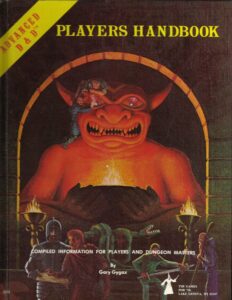In my last essay, I discussed the relationship between hit points, armour class and the survivability of the character. It occurred to me that in Dungeons & Dragons 5E, Armour Classes exist in a fairly narrow range and are achieved by two primary methods. Either by having a good Dexterity and wearing light armour or by wearing heavy armour and caring not about Dexterity. A few class abilities also come into it.
However, for any melee character, you will likely find their armour classes comparable.
This, unfortunately, tends to elevate the Dexterity-based character as there are more things that Dexterity is good for (such as Initiative and Stealth), and is a design challenge that 5E hasn’t solved yet.
I then got to thinking about how melee characters armour classes worked in previous editions. In AD&D, your rogue had an AC of 8 less the Dexterity modifier (if 8 seems low, this is in the days of descending ACs, where 10 was worst and 0 was very good). So, an AC of 4-6 (14-16 today) seems likely. Meanwhile, the beginning fighter wore banded mail and shield for an AC of 3 (17), but could benefit further from Dexterity. Yes, in those days heavy armour did not negate the Dex modifier. (Although there’s a note in the encumbrance table that implies it might).
But there was one melee class that had a truly awful armour class. I speak of the monk, which I believe is the most poorly designed class ever to end up in an official rulebook.
The Survivability of the Monk
A first level monk had a 10 Armour Class. That’s what it said in the class’s description. Dexterity did not affect it, unlike every other class.
Hit points? 2d4. A good Constitution score could raise that to 2d4+4, but that was scant consolation.
This is a class that is explicitly designed as a hand-to-hand martial artist, but when attacking with “open hands” deals 1d3 damage. Yes, less than a magic-user with a dagger. Strength bonuses applied to the damage roll (if the Monk had a 16 or better Strength), but not attack bonuses.
How bad was an AC of 10? An orc would hit the monk on a roll of 9 or higher on a d20. And let me tell you, healing was hard to come by in those days.
So, here is a class for melee fighting with open hands – and it is bad with every aspect of that.
It Eventually Gets Better!
At high levels, the monk isn’t so bad. It finally deals significant damage, has a chance of stunning or killing opponents when it has them, and has one of the best armour classes in the game.
Although they had to defeat opposing monks of the same level each time they wanted to advance to the higher levels. So, a 50/50 chance of gaining each higher level?
What on earth is going on with this class?
There’s this thread running through AD&D (in particular) that some classes are so powerful that they can only be balanced by being terrible at low levels.
But it’s a bit deeper than that, because then you look at the thief and its chances of performing any of its thiefly abilities. A 20% chance of opening a lock or disarming a trap? Why do we have you along, Mr Thief?
However, there are none that are egregious as the monk.
Is it better, yet?
The monk made a return in D&D 3E, after mostly being excluded from AD&D 2E. (It appeared in some supplements). And it appeared that the designers took to heart that it had trouble surviving, because they made it the most defensive class in the game. Great saving throws and armour class.
Unfortunately, its attacks were underwhelming.
They were so underwhelming that the monk’s primary ability seemed to be to make combats last longer. The monsters couldn’t damage it, and it couldn’t damage the monsters.
I think we finally got an effective monk when 4E came along. 5E monks are also pretty good.
There’s a Dragon Magazine version of the 1E monk which isn’t that bad.
The Effective Class
I strongly believe that it is fine for a class to get better later. That it doesn’t need to be good at everything from the beginning.
However, you need something distinctive that you’re good at early on. In AD&D, magic-users got to cast sleep and win fights. They were pretty poor most of the rest of the time, but they could be game-winning often enough to make them feel special. In 5E, the rogue gets to sneak attack from first level, using their allies and stealth.
What does the ranger in 5E do early on that is distinctive? I’m not that sure, but they aren’t that bad in combat. Certainly not as bad as the AD&D monk!

